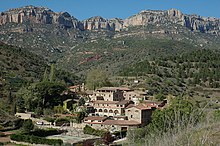Cartoixa D'Escaladei
History
Foundation and early history
The monastery was established by king Alfonso II of Aragon as the first Carthusian monastery in the Iberian peninsula in 1194. The reason was the recent reconquest of the territory of Catalunya Nova from the Moors and for which the Aragonese kings needed to repopulate the territory. The location proved fitting for the community which was seeking silence, solitude and nature. According to legend, when the Carthusian monks came into the region they met shepherd who told them that he had seen in a vision angels ascending a stairway into heaven into the clouds of the summit of nearby Montsant.
By 1218 the monks were well established and were gifted by Jaume I dominion and jurisdiction over the nearby villages of La Morera, Gratallops, Torroja, Porrera, Poboleda and Vilella Alta. The monks introduced viticulture in this region, resulting in first vines in 1263, and the villages form today the wine region of Priorat. Scala Dei's patron saint became the founder of the Carthusian order, Saint Bruno of Cologne, whose feast day in the first week of October coincided the beginning of the vine harvest.
The earliest building of the monastery is the church of Santa Maria which was finished in 1228. Together with it were built a first cloister, called Maius, twelve cells for twelve monks and several other buildings. Thanks to the aid of prince and patriarch Joan of Aragon, the monastery could build another cloister in 1333 and build twelve additional cells, thus doubling in size. A third cloister with six cells was built in 1403 with donations from Berenguer Gallart, lord of Puigverd.
Though the community lived mostly in silence, it was also in contact with the outside world. The physician Arnaldus de Villa Nova dedicated one of his treatises to the prior and monks of Scala Dei and bequeathed some of his books to them upon his death in 1305. Alonso Tostado, a leading scholar of the 15th century, was a novice here in 1444 before he was called by king Juan II to become his advisor.
Early Modern History
In the 16th century a rebuilding programme begun which continued throughout the 17th and 18th century, giving the charterhouse a Baroque, Neoclassical appearance. During that time the charterhouse became an important regional artistic centre, notably among other for the Escaladei school of painting. Among those painters were friar Lluís Pascal, friar Ramón Berenguer (died 1660) and Joaquim Juncosa. The later became a lay friar at the monastery in 1660 and became one of the most famous painters of Catalan Baroque. Juncosa painted several portraits and frescoes at the monastery, unfortunately all of them were lost in the following events. The monastery became also became an important centre for books. For instance, one of the only two Catalan cookery manuscripts, El llibre de la Cuina de Scala-Dei, dates to the first half of the 17th century and the book Commentariam in Ieremiam Prophetam by Andrés Capilla (d.1610) was published here.
Demise and destruction

In 1835, following the decrees of Mendizábal for the seizure of monastic property, the community was forced to leave their home. In the surge of radical anticlericalism, revolutionary mobs, incited by liberal agitators, begun burning convents, starting first in Barcelona but also reaching monasteries in the country side such as the Cistercian monastery of Poblet, the Benedictine monastery of Sant Cugat and also Scala Dei. Only one day after the monks left, the monastery was sacked and a few days later it burned down. Thus, after just two years the conventual buildings were nearly entirely destroyed. The surviving buildings were sold at an auction in 1843 by five families who founded in 1844 a company to produce wine, the Sociedad Agrícola La Unión.
Today
Since 1989 the ruins were donated by the former proprietors to the Catalan ministry of Culture. The monastery has been renovated in recent years and the ruins can now be visited.

References
- ^ "Carthusian Monastery of Escaladei". Monuments de Catalunya. Generalitat de Catalunya. Retrieved 26 November 2023.
- ^ Bahrami, Beebe (2009). The Spiritual Traveler Spain : a Guide to Sacred Sites and Pilgrim Routes. Paulist Press. p. 206. ISBN 9781587680472. Retrieved 27 November 2023.
- ^ "History". Cellers Scala Dei. Cellers ScalaDei. Retrieved 26 November 2023.
- ^ Arnaldus de Villanova (1981). Paniagua, Juan Antonio; García Ballester, Luis; Rogers McVaugh, Michael (eds.). Arnaldi de Villanova De esu carnium. Publicacions de la Universitat de Barcelona. p. 149. ISBN 978-84-7935-563-0. Retrieved 27 November 2023.
- ^ Gerli, E. Michael (December 2013). Medieval Iberia An Encyclopedia. Taylor & Francis. p. 525. ISBN 9781136771613. Retrieved 27 November 2023.
- ^ Miralpeix Vilamala, Francesc. "Joaquim Juncosa Donadeu". Real Academia de la Historia. Retrieved 26 November 2023.
- ^ Davidson, Alan (1983). Food in Motion The Migration of Foodstuffs and Cookery Techniques : Proceedings : Oxford Symposium 1983 · Tomo 1. Prospect Books. p. 178. ISBN 9780907325079. Retrieved 27 November 2023.
- ^ Crossley, John N. (2011). Hernando de Los Ríos Coronel and the Spanish Philippines in the Golden Age. Ashgate. p. 123. ISBN 9781409425649. Retrieved 27 November 2023.
- ^ Hughes, Robert (December 2011). Barcelona. Knopf Doubleday Publishing Group. p. 217. ISBN 9780307764614. Retrieved 27 November 2023.
External links
- Information and images inMonasterios de Catalunya
- "Carthusian Monastery of Escaladei - Website of the Monuments de Catalunya". Information about visit. Retrieved 26 November 2023.